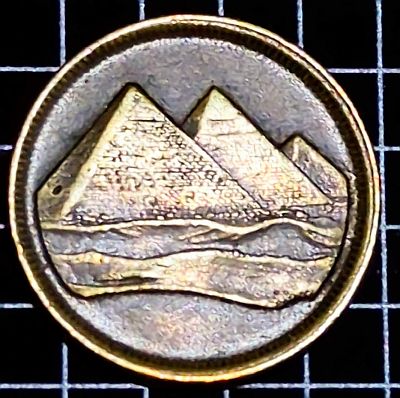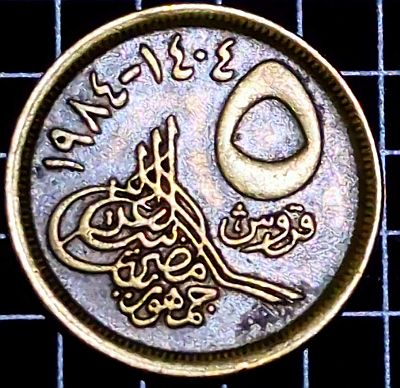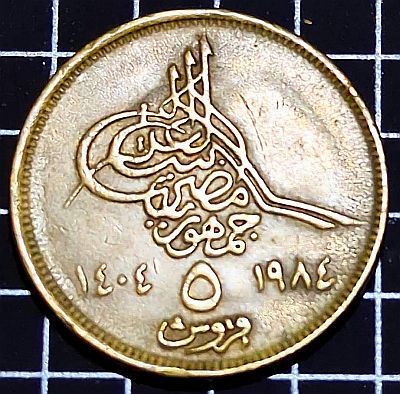A pair of classical designs from the middle-east
Reverse

The reverse is anepigraphic, but instantly recognisable to most people around the world. The Great Pyramids of Giza are one of the seven wonders of the ancient world, and still a marvel of building that we are still discovering more about even today. Ancient Egypt was an amazingly long-lived civilisation, reliably dated to around 3,100 B.C., up to the Roman Empire in 30 B.C.
However Egyptian civilization existed long before this period, and it has survived and flourished since. While the civilization’s rulers, language, writing, climate, religion and borders have changed many times over the millennia, Egypt still exists as a modern-day country.
The Pyramids of Giza are some of the longest surviving buildings, and in fact, there are even older pyramids in Egypt, in Djoser, so the whole country is impressive and fascinating.
Obverse

The obverse of the coin features a tughra. Introduced by the sultans of the Ottoman Empire (of which Egypt was a part)). The tughra is the signature of the sultan, similar to the Royal Cypher used by British monarchs. Very ornate in design, it is a specific form of Arabic Calligraphy.
Interestingly, there are two versions of this coin, the other version has a larger Tughra with the other details below:

In both cases, the coin also shows the western year (1984) and Islamic year (1404), as well as the value, all in “Eastern Arabic” numerals. What are Eastern Arabic numerals, you didn’t ask? I’m glad you asked!
Arabic numerals
Saying the text is in Arabic is relatively straight forward. Arabic script dates back to the 1st or 2nd century B.C. It is a language which is written right to left, and is used across the Arabic-speaking world. When talking about numbers, however, it gets a little trickier.
The numbers which English speakers are familiar with: 0 1 2 3 4 5 6 7 8 and 9 are actually called “Arabic numerals“. Technically “Western Arabic Numerals” or “Hindu-Arabic numerals“. One possible reason behind this is that while Latin numerals (I, II, III, IV, V, VI, VII, VIII, IX and X being 1 to 10) continued in use in Europe long after the fall of the Roman Empire, they aren’t ideal for accounting or calculations. Arabic style numbers were introduced by Arabic traders and treaties, although didn’t really take off until the 14th – 15th centuries.
“Eastern Arabic numerals” also use ten characters for the numbers 0-9: ٠١٢٣٤٥٦٧٨٩. As noted by one comment on this Guardian page, most of the numerals do have similarities, “In Arabic script, 1 is a vertical stroke, 2 and 3 are like 2 and 3 on their sides, and 7 is a V-shaped symbol; like 2 and 3, rotated 90 degrees. 9 is identical, while zero is a dot – basically a small filled circle.” These similarities make sense as both number systems originated from the same roots.
One interesting thing about Arabic numbers is how they are read. Arabic text is written and read right to left. Numbers, however, appear to be written left to right. There are various opinions as to why this is. The most common explanation I found is that numbers ARE still written and read right to left. Western readers are used to the most significant digit being on the left and read first, 1234 is read as “One-thousand, two-hundred and thirty-four”. in Arabic, the same number is written ١٢٣٤ (with the ١ for one on the left), but traditionally is read “four and thirty after two-hundred after a thousand”. From the same page, in modern usage this is often only done for numbers less than a hundred (“One-thousand, two-hundred and four and thirty”).


Leave a Reply